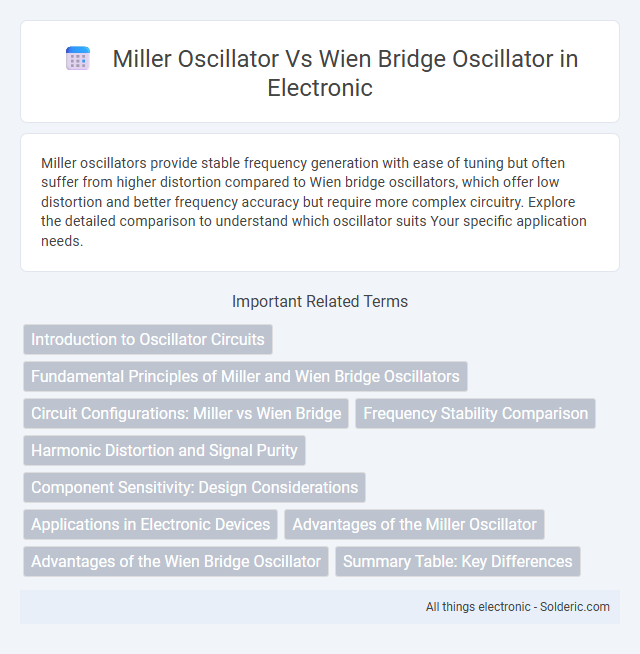Miller oscillators provide stable frequency generation with ease of tuning but often suffer from higher distortion compared to Wien bridge oscillators, which offer low distortion and better frequency accuracy but require more complex circuitry. Explore the detailed comparison to understand which oscillator suits Your specific application needs.
Comparison Table
| Feature | Miller Oscillator | Wien Bridge Oscillator |
|---|---|---|
| Oscillation Principle | Uses capacitive feedback via Miller effect | Uses RC network for frequency selection |
| Frequency Stability | Moderate stability | High stability |
| Frequency Range | Wide frequency range | Typically low to mid frequencies |
| Waveform Output | Square or sawtooth waveform | Sine wave output |
| Application | Clock generation, waveform synthesis | Audio frequency generation, sine wave sources |
| Complexity | Simple design | More complex, requires amplitude stabilization |
| Amplitude Stability | Less stable amplitude | Better amplitude stability with automatic gain control |
Introduction to Oscillator Circuits
Oscillator circuits generate continuous waveforms essential for communication and signal processing applications. The Miller oscillator employs an amplifying device with a feedback capacitor to produce stable frequency oscillations, while the Wien bridge oscillator uses a frequency-selective bridge network combining resistors and capacitors to achieve low-distortion sinusoidal output. Both oscillators utilize feedback principles but differ in circuit topology, frequency stability, and waveform purity.
Fundamental Principles of Miller and Wien Bridge Oscillators
Miller oscillators use a phase-shift network with capacitive feedback to produce a stable sinusoidal output by exploiting the Miller effect, where an amplified inverted signal feeds back to sustain oscillations at a frequency determined by the RC network. Wien bridge oscillators rely on a frequency-selective feedback loop comprising a series RC and parallel RC branch, allowing precise frequency control and distortion-free sinusoidal wave generation. Your choice between Miller and Wien bridge oscillators depends on the desired stability, frequency accuracy, and signal purity for your application.
Circuit Configurations: Miller vs Wien Bridge
The Miller oscillator uses a feedback capacitor connected between the collector and base of a transistor to produce oscillations, relying on phase inversion and gain in a single amplifier stage. The Wien bridge oscillator employs a frequency-selective Wien bridge network consisting of resistors and capacitors, combined with an operational amplifier or vacuum tube to sustain sinusoidal oscillations. Miller oscillator circuits are typically simpler with fewer components, while Wien bridge oscillators provide more stable frequency control due to the precise RC network configuration.
Frequency Stability Comparison
The Wien bridge oscillator offers superior frequency stability due to its reliance on a frequency-selective RC network that maintains consistent oscillation with minimal drift over time. In contrast, the Miller oscillator, employing active components and feedback through transistor capacitances, tends to experience greater frequency variations influenced by temperature and component tolerances. Your choice should weigh the Wien bridge oscillator's precise frequency control against the Miller oscillator's simplicity and ease of design.
Harmonic Distortion and Signal Purity
The Miller oscillator typically produces higher harmonic distortion due to its feedback configuration, resulting in less signal purity compared to the Wien bridge oscillator. The Wien bridge oscillator is favored in applications requiring low harmonic distortion because its frequency-selective feedback network generates a near-pure sine wave output. Engineers often choose Wien bridge oscillators for audio and precision signal generation where minimal harmonic distortion and high signal fidelity are critical.
Component Sensitivity: Design Considerations
Miller oscillators exhibit lower component sensitivity due to their reliance on transistor capacitances and fewer passive components, making them more stable against parameter variations. Wien bridge oscillators require precise resistors and capacitors for frequency accuracy, demanding high-quality components and careful component matching to minimize drift and distortion. Understanding these design considerations is crucial for optimizing your circuit's performance in applications requiring frequency stability.
Applications in Electronic Devices
Miller oscillators are commonly used in RF circuits and high-frequency applications such as signal generation and frequency synthesis due to their stability and ease of integration. Wien bridge oscillators are preferred in audio frequency applications, including tone generators and sound testing equipment, because of their low distortion output and frequency accuracy. Your choice depends on the required frequency range and signal purity for the specific electronic device application.
Advantages of the Miller Oscillator
The Miller oscillator offers high-frequency stability due to its use of a capacitor connected in the feedback loop, which provides better control over oscillation frequency compared to the Wien bridge oscillator. Its simple design with fewer components leads to increased reliability and ease of integration in IC circuits, making it ideal for RF applications. Moreover, the Miller oscillator delivers low distortion and improved phase noise performance, enhancing signal quality in communication systems.
Advantages of the Wien Bridge Oscillator
The Wien Bridge Oscillator offers superior frequency stability and low distortion due to its use of a frequency-selective feedback network based on resistors and capacitors. It provides a wide and easily adjustable frequency range without requiring inductors, making it ideal for audio and low-frequency signal generation. Compared to the Miller oscillator, the Wien Bridge design typically delivers smoother sinusoidal waveforms and simpler amplitude control mechanisms, enhancing overall signal quality.
Summary Table: Key Differences
The Miller oscillator relies on a single transistor or op-amp with a capacitive feedback network, producing frequency stability primarily through the Miller effect, while the Wien bridge oscillator uses a bridge circuit with resistors and capacitors to create a highly stable sine wave output. Miller oscillators are simpler and offer frequency tunability but typically have less harmonic distortion control compared to Wien bridge oscillators, which excel in low distortion and precise frequency generation. Wien bridge oscillators are preferred for audio and signal processing applications due to their superior waveform purity and frequency accuracy.
Miller oscillator vs Wien bridge oscillator Infographic

 solderic.com
solderic.com